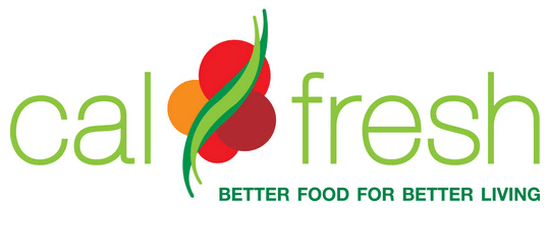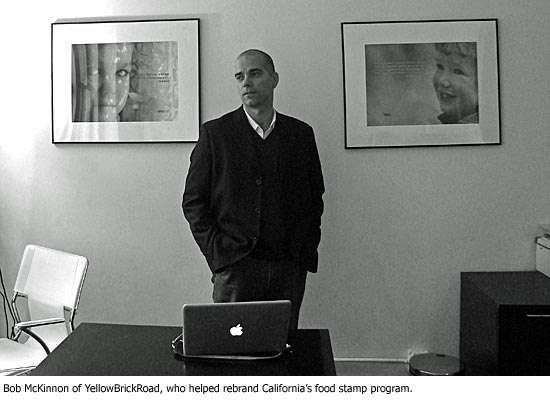A CalFresh start
November 19, 2010
It was a long time ago, but when Bob McKinnon traces the successful trajectory of his life—his Madison Avenue advertising career, the creation of his own boutique firm—he thinks about food stamps.
He remembers how they helped him eat better so he could study harder. His mom, a single mother of three, had been diagnosed with cervical cancer and needed help from the government to steady her family during the rough patches.
But McKinnon also remembers the way some people denigrated that helping hand, calling it a handout “for people who are lazy or aren’t trying.” And, in that regard, not much has changed over the years. The stigma lingers. Only now, McKinnon, 41, is in the forefront of a movement in California to do something about it.
McKinnon, the founder of a public-spirited communications and advocacy firm in New York, was enlisted to help California rebrand its food stamp program in the hopes of undoing decades of negative stereotypes and encouraging eligible participants to step forward and sign up.
In October, California’s food stamp program officially became known as “CalFresh: Better Food for Better Living.” The name—and accompanying logo—followed months of consumer research, strategy sessions, stakeholder meetings and focus groups from Merced to San Bernardino, comprised of low-income Californians receiving assistance or eligible for it.
“Looking back, to think that at some point my mom had to feel badly for even a second to help us, bothers me to do this to this day,” says McKinnon, whose company, YellowBrickRoad, specializes in “advocacy communications” on issues ranging from childhood obesity to climate change. “Do critics of these programs really think people don’t want to feel pride?”
The rebranding process began two years ago, when the U.S. Department of Agriculture changed the name of the food stamp program to the Supplemental Nutrition Assistance Program, or SNAP. The change was made to reflect the reality that food stamps and scrip were abandoned years ago in favor of electronic debit cards. The federal government told the states they could adopt the same name for their programs or come up with new ones.
California seized the challenge like no other—for good reason.
The state’s 3 million food assistance recipients represent just half of those eligible for the benefits. Only Wyoming has a worse record. As a result, California has been missing out on an estimated $4.9 billion in federal nutrition assistance that would flow through the state’s ailing economy. The program pays a monthly benefit of $200 for an individual and $526 for a household of three.
The California legislature, with a strong push from Oakland-based California Food Policy Advocates, passed a bill in 2008 by Assemblyman Jim Beall, Jr. that not only called for the creation of a new name but also lifted asset restrictions that effectively required some applicants to exhaust virtually their entire net worth to qualify.
“One of the things we wanted be clear about is that we didn’t want to put a new name on an old program,” says George Manalo-LeClair, senior director of legislation for CFPA, which assured lawmakers that no public money would be spent on the process. “We recognized that this was not the No. 1 priority for the state.”
To research and test potential names for the state’s Department of Social Services, The California Endowment stepped in with a grant of $150,000, enough to cover some of the costs of YellowBrickRoad and Lake Research Partners, which conducted the focus groups.
Manalo-LeClair says his group and others were determined to come up with a name that would resonate positively with potential participants, many of whom have been hit hard by the economy but could not see themselves applying for food stamps. The idea was to create branding that stressed the nutritional, rather than the welfare, aspects of the program.
California officials, Manalo-LeClair says, didn’t want to follow the path of the federal government, which “took words that the House liked and that the Senate liked and squished them together.” The result, he says, was a name that focus groups agreed conjured up images of a welfare program with “long lines and hassles.”
It was during these sessions, as interviewers asked participants to offer words that suggested healthy eating, that “fresh” first surfaced. Many involved in the process liked that it worked on two levels—fresh, as in fresh food, and fresh, as in “you’ve hit rock bottom and need a fresh start,” as McKinnon put it.
Some within the bureaucracy, however, weren’t nearly as thrilled when presented with the proposed CalFresh name. They thought it was vague and confusing. Without the tag line, it didn’t even allude to the program’s key aspirations—to provide food and help. How would people know even to apply?
“When you’re dealing with government stakeholders, they want to come up with a lot of acronyms,” McKinnon responds. “But you’ve got to ask: Who is our audience? We need to make sure that the name appeals to them first. To us, a little bit of abstraction was perfectly acceptable so people could see themselves in the program.”
But the criticisms from the insiders, who were concerned about the program’s success, were mild compared to those that came after California’s first lady Maria Shriver unveiled the rebranding during a media event in Long Beach. Conservative radio hosts and bloggers feasted on the change.
Typical among them was this from self-proclaimed “Advice Goddess” blogger Amy Alkon, the author of a recent book bemoaning the lack of civility in American life : “Sorry, but there should be a stigma against using food stamps…My parents raised us to think it was shameful not to support yourself.”
Food advocates in and out of government seethe when they hear intentionally provocative off-the-cuff takes like these, which misrepresent the demographics of those receiving help and the impact of the nation’s economic meltdown on working families. The fact is that children represent roughly half of the recipients.
“Someone with an opinion like that might lose their job tomorrow and then need food assistance themselves,” says Judith Lilliard, who oversees the food stamp program for Los Angeles County’s Department of Public Social Services. “We’re trying to build a healthy society here. We don’t want people starving in the streets because they’re embarrassed to apply for food stamps.”
To that end, Lilliard’s department has been a leader in streamlining the application process, allowing people to sign-up by mail, phone and, soon, through the Internet. The county also recently began a mobile service, dispatching a computer-outfitted truck into neighborhoods with high numbers of eligible participants.
Underlying all these efforts, Lilliard says, is recognition by the county that many of the working poor will not enter a government building to apply for food assistance because they feel it’s humiliating.
Lilliard, like McKinnon, knows something about that feeling.
In the mid-1960s, she grew up in housing projects in East L.A. and low-rent apartments in South-Central. She remembers tagging along with her mom to pick up the family’s food stamps, which back then were distributed by banks. The recipients were told to line up outside at a walk-up teller.
“I remember thinking, “This is not right. Why are we out here when they have a perfectly good building,’ ” Lilliard says. “The bank felt that people getting food stamps weren’t good enough to go inside the building.”
Lilliard says that, over the years, she’s held a variety of positions within her department’s general relief and food stamp division. (“We’ll be renaming that soon, by the way.”) But it was her pre-teen years that Lilliard says have given her a special qualification for her job as division chief—empathy.
“I’m good at being able to put myself in someone else’s shoes,” she says, “because I’ve been there myself.”














 405 bridge work causes a stink
405 bridge work causes a stink

